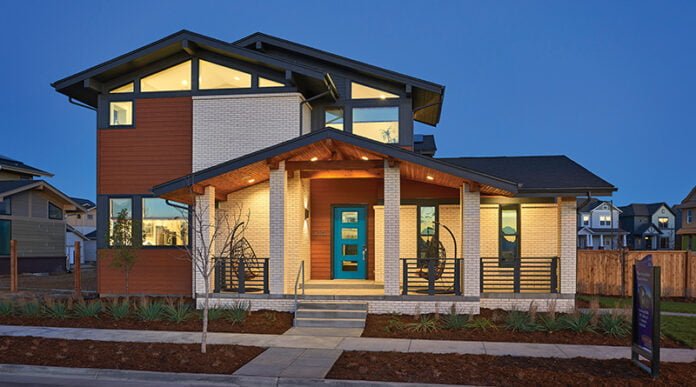A report from Dodge Data & Analytics, “Green Multifamily and Single-Family Homes 2017,” found that a third of single-family builders say most of their projects are green builds. Almost 60% of single-family builders consider themselves a dedicated green builder, using environmentally friendly building standards on over 90% of their builds.
The report, published in September 2017, found that small builders were more likely to identify as green.
While green building is currently a niche filled by small builders, analysts at Dodge believe that by 2022, the percentage of large and small firms using green standards on at least 90% of their jobs will be roughly equal.
Energy efficiency through green standards
Green building can mean different things to different people, but an important part is energy efficiency.
Energy efficiency is baked into Thrive Home Builders’ philosophy, practices and business model. The Denver-based builder has been putting up energy efficient homes since the company was founded as Greentree Homes in 1992, “back before green was cool—and viable, to be very candid,” Thrive CEO Gene Myers said.
“We didn’t feel, initially, that green would pay for itself, so we focused on energy efficiency where we could document the savings,” Myers said.
Small builders can’t compete head on with large production builders, according to Myers, and green building gives the company a leg up.
“We have to be highly differentiated. We have a very highly differentiated brand, and we’re doing stuff that no other builder does,” he told Colorado Builder.
Michael Carrier, president of Alpenglow Building and Design in Durango, has also found that energy efficiency and green building help distinguish his firm from the competition while serving homeowners’ needs.
A graduate of Montana State’s architectural program, Carrier got into building as a way to complement his architectural education. He found a disconnect between architects and builders, where architects were “overdesigning for a client’s budget, and that wouldn’t be known until a builder came along well after the design was completed [and] clients had already paid.”
“You had an unhappy client, you had a bitter builder who was trying to cut corners, and you had an architect who didn’t produce a service as well as they should have,” he said.
3 steps to Thrive
Thrive’s brand stands on three legs: healthy, efficient and local.
All of Thrive’s builds meet the standards for the Environmental Protection Agency’s Indoor airPLUS program, which aims to minimize indoor air pollutants including biological agents like mold and pollen, and chemical agents like VOCs, formaldehyde and radon.
Although Coloradans’ proximity to the Rocky Mountains gives us access to great hiking and skiing, it also puts us at high risk of exposure to radon, a radioactive gas that can lead to cancer. The Colorado Department of Public Health and Environment states that about half of homes statewide have radon levels that are above the EPA’s recommended action level.
It’s not just the materials used in building or naturally occurring elements that can pose a risk to indoor air quality. Carpet and particle board used in mass-produced furniture are big offenders, as well as cabinets and paint. Even if a house is completely free of pollutants when the homeowner takes possession, the things they bring into the home can introduce chemicals.
Proper ventilation is key to maintaining clean indoor air once builders complete a project and no longer control the home.
Myers, a former civil engineer, explained, “When I went to school, the Clean Water Act was passed. The catch phrase was, ‘The solution to pollution is dilution.’ That’s true with air” as well.
Thrive uses local beetle kill lumber in its builds. The mountain pine and spruce beetle infestations have impacted over 5 million acres of forest in Colorado since 1996, according to the Colorado State Forest Service.
“Can anything good come from this?” Myers said. “Yeah, we can build your house from that.”
But what Thrive is really known for is energy efficiency, Myers said. The firm has a slew of awards recognizing its successes from the HBA of Metro Denver and Green Builder and Green Home Builder magazines. The firm has won the Department of Energy’s Grand Award, which recognizes housing innovation, every year since 2013.
Thrive builds around 200 houses per year, about 20% of which are net-zero production-built houses, Myers said.
With its Z.E.N. (Zero Energy Now) line of homes, launched in 2013, Thrive builds homes that can generate as much renewable energy as they consume. Myers and his team turned to the available resources from Oakridge National Lab, the National Renewable Energy Lab, and Passive House software to develop three two-story single-family zero-energy floorplans.
Passive passion at Alpenglow
Green building and energy efficiency have always been a passion for Alpenglow’s Carrier. About five years ago, he took on a job for a client who wanted a passive house.
“Not really knowing what a passive house was beyond being passively solar-oriented,” Carrier said, he turned to the Passive House Institute US to learn more.
“That really opened my eyes,” he said. “The passive house model reduces energy consumption in a building by 70% to 90%.” Attempts to quantify exactly how much passive building standards reduce energy consumption in a building have come up with a wide range of results. A 2015 study out of the U.K. found that passive energy saving methods reduced energy consumption by about 33%. The same year, Passive House Institute published an analysis of energy consumption across several multifamily buildings in Germany that found consumption fell 81% compared to traditional building methods.
Related: How phase change materials can impact building efficiency
Carrier said that in the mountain communities of the Western Slope, between 45% and 50% of the energy produced goes to building conditioning “because of the extreme day- and nighttime temperatures, and the intense sun of the summers.”
Now about two-thirds of Alpenglow’s projects are passive or net-zero homes, and one of Carrier’s goals is to focus exclusively on that type of building.
For one thing, it’s perfect for Colorado homeowners.
“The climate we have here is fairly predictable,” he said. “We have great sunshine. It’s typically dry; we don’t have a lot of humidity. Those are huge bonuses for moisture management and capturing free heat” from the sun.
Like Thrive, Carrier also tries to source local materials for his projects.
“The building industry in general is fairly wasteful,” he told Colorado Builder, but there are ways to be more efficient on job sites.
“In Southwest Colorado in particular, we have a lot of locally produced materials,” he said, like logging and mill operations.
Who buys green?
Green buyers bring to mind a certain type of homeowner, one that’s not too far off the mark for Thrive.
“She’s a 35-year-old woman who drives a Prius, shops at Whole Foods and has Boulder-like tendencies,” Myers said of the typical Thrive customer. “That doesn’t mean that’s the only segment we appeal to.”
For example, net-zero homes are an attractive selling point for aging boomers who are on a fixed income or will be soon. “They’d like to fix their expenses. We get them into a zero-energy home, and they don’t have to worry about what happens to utilities in the future,” he said.
Passive housing is more entrenched in Europe, where energy-efficient building principles have been part of codes since the early ’90s, Alpenglow’s Carrier noted. It’s been slower to take root in the U.S., though.
He said it comes down to money.
“It becomes, very quickly, a financial discussion with most of our clients,” he said. “There’s a premium to build to the passive level.”
Related: Cost saving and resale rates make green homes attainable
Nationally, a 15% premium on passive homes is about average, according to Carrier, and “considering most houses have a 10% change order contingency built into the budget, that doesn’t seem like that much.”
As usual, though, the devil is in the details, he said.
“If you are putting 10% to 15% in the project up front, how long is that payback time? That’s a tough nut to crack for a lot of our clients.”
For example, on a $1 million home, that premium amounts to $100,000. “It’s really easy to take that $100,000 and put it in stocks or bonds and make money with it,” he said.
Carrier has been able to push down the passive-house premium on some of his projects to 5% or even 2%.
“A lot of that is due to smart design up front. If we know we want to put as many passive elements in a house but we’re not exactly sure how it’s going to work out, we’ll come up with a floor plan, we’ll do a soft bid and see where we’re at,” he explained.
While financial considerations are certainly a concern to some clients, Carrier has found awareness is a challenge as well.
“The term ‘passive house’ is a difficult one for people to understand,” he said. Net-zero, net-zero-ready and net-positive may be more readily understood by clients, he suggested. “Even ‘high-performance housing,’ that seems to be a little more understood by people.”
Green standards for good
Carrier gets frustrated with “green washing”—builders who say they’re putting up efficient, sustainable homes but are just using ENERGY STAR-rated products without following green building standards or testing the homes’ performance.
“Most builders out there are going to build as cheap as they can and charge as much as they can; that’s just the law of business,” Carrier said. “In my mind, it seems like just building a code-built house is a disservice to a client. It’s going to cost a lot of money long-term. It’s not going to be nearly as durable or comfortable or healthy.”
Thrive’s Myers has a “bad joke” he likes to share that gets to the heart of why he does what he does.
“‘I joined the Peace Corps to save the world. It must have worked because we’re still here. You’re welcome,’” he says.
That faux conceit is a joke, but the underlying optimism is not.
“There’s a spark of idealism still there that we can bloom where we’re planted,” Myers said. “I’m a builder; I’m not going to save the world, but I can change the world for the people who buy our homes.”








